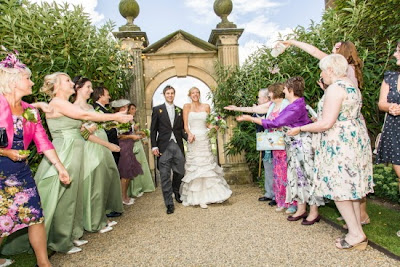First of all this guide is not intended for professional
photographers, who with years of experience will have their own preferred
settings.
Many of the camera users I know, including those I spot at
weddings taking pictures have their cameras permanently stuck in auto mode. I
am not knocking auto mode because a lot of knowledge and electronic wizardry
has gone into making this a “best fit” option for many photographers. I just
wanted to let you know how you can use some of the other settings to perhaps
take an even better picture.
TV – Shutter Priority. When you select this mode, you are
telling the camera which speed to use, the electronics in the camera then work
out the best aperture for a perfect exposure. So why is shutter speed
important? If you are taking pictures of
motor cars racing, or your children running in the park, if you have a fast
shutter speed you are more likely to stop the action perfectly. If you had a
slow shutter speed then you would find that the cars were blurry and perhaps
the arms and legs of your children.
“At a wedding” – I choose speeds faster than 1/60th to ensure there is no
blurring. However during the first dance I switch between speeds and I prefer
slower than 1/10th as this captures the movement in the brides dress
as she is swept across the dance floor.
AV – Aperture Priority. When you select this camera mode,
you are instructing the camera which aperture to select. Once again the cameras
electronic circuits work out the best shutter speed for a perfect exposure. The
most common use of aperture priority is to control the amount of background
blur.
“At a wedding” – I choose a wide aperture f16 or above to
ensure everyone in a group shot is in focus and so is the background. I would
chose an aperture of f4 if I wanted to blur the background.
M - MANUAL . You set both the shutter speed and the aperture.
There is no need to fear this setting. You use the light meter indications
inside the camera viewfinder to either expose correctly, or under or over
expose as necessary.
“At a wedding” – I would use manual mode sparingly.
Preferring to use either TV or AV.
P – Program. If you
are a beginner and haven’t got time to work out the best settings for shutter
speed and aperture, then please use this mode. The camera adjusts the settings
for you automatically. Keep an eye on them though, as shutter speeds can drop
down and cause motion blur at lower light levels.
“At a wedding” – If I wanted to get a lot of general shots
in similar lighting conditions I would use Program. Why? Because sometimes
getting “the shot” or “capturing the exact moment” is more important that
twiddling knobs!
ISO – This is the one important factor, not controlled with
the mode knob, but is heavily interlinked with its use. The higher the ISO
number the more sensitive the camera senor is to light. So you would choose a
higher ISO number when shooting inside a church, for instance. Be careful
though, because the higher the ISO the grainier or noisier your pictures become.
Try taking a series of pictures at different ISO settings. When things get too
noisy, go back a setting and then try not to use the higher settings unless it
is a must have shot.
Photography either as a professional or as an amateur should
be fun. Get out there and experiment, using the different modes and see what
effects this has on your pictures. There are still lots of camera clubs about
and certainly lots of forums to help you on the internet. Take lots of photographs
and do print the ones you like. Photographs look different in print, than on
your computer screen.
Duncan Malloch has been a keen photographer since the age of
9. At 10 he was taking, developing and printing black and white photos in his
own darkroom. In 1984 he shot his first wedding as a professional. Since then
he has won awards from the master photographers association and taught
photography at a local college.




















